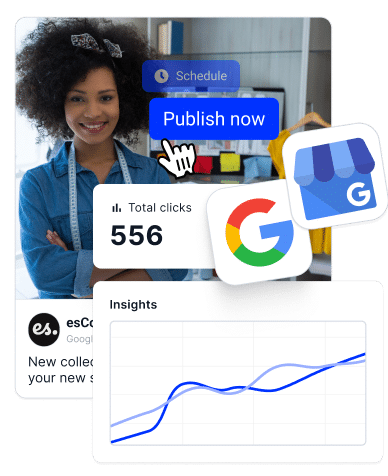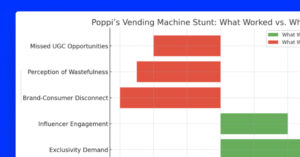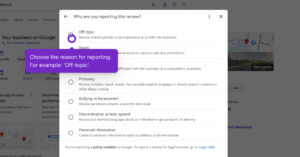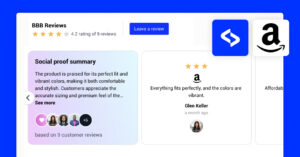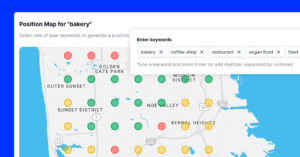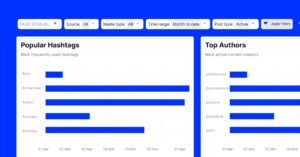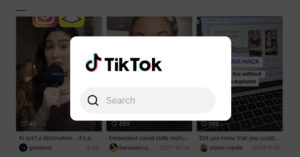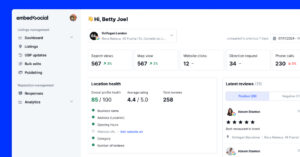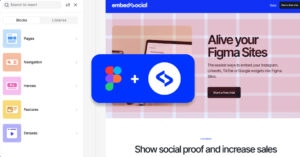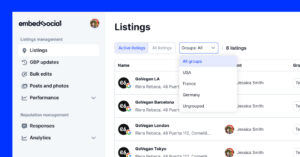When you’re managing a local business, your online visibility is essential, as showing up in Google Search and Google Maps drives customers to your door.
But how do you know if your business is actually performing well in local search? Well, you can get that information from a local SEO report, which shows you how visible your business is, where you stand in local rankings, and what you can do to improve.
That said, I’m breaking down exactly what a local SEO report is, what it should include, and how to use it to optimize Google Business Profile locations.
Here’s how you improve local search visibility and turn insights into wins.
What is a local SEO report, and why is it important?
Unlike general SEO reports that focus on website traffic and backlinks, local SEO reports track how your Google Business Profile (GBP) is showing up in a search engine for local searches, what keywords you’re ranking for, and how customers are engaging.
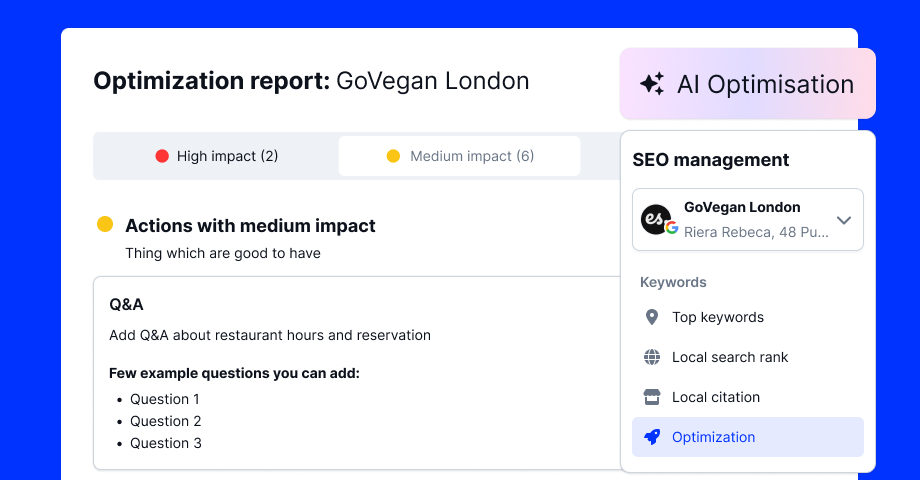
A local SEO report is a document or dashboard that outlines how well your business is performing in local search results—especially on Google (Maps & Search).
These reports typically include:
- GBP performance data—views, clicks, calls, and direction requests;
- Local keyword rankings—your position for key search terms in specific areas;
- Review performance—number, quality, and frequency of customer reviews;
- Citation accuracy—whether your name, address, and phone number are consistent across directories.
As such, local SEO reports should be actionable and tell you:
- Where you’re ranking well and where you’re not;
- Which areas of your GBP need improvement;
- Steps to take to boost your visibility and conversions.
If your local SEO strategy is to rank higher on Google Maps, get found by “near me” searches, and improve foot traffic or calls, then reviewing a local SEO report regularly is a must. It’s your roadmap to outperforming local competitors based on data, not guesswork.
What should a local SEO audit report include?
You know you got a great local SEO audit report if it teaches you everything about what’s working, what’s not working, and what you need to fix next.
Here’s some of the information your SEO optimization report should include so you can monitor local search performance and boost your local SEO efforts:
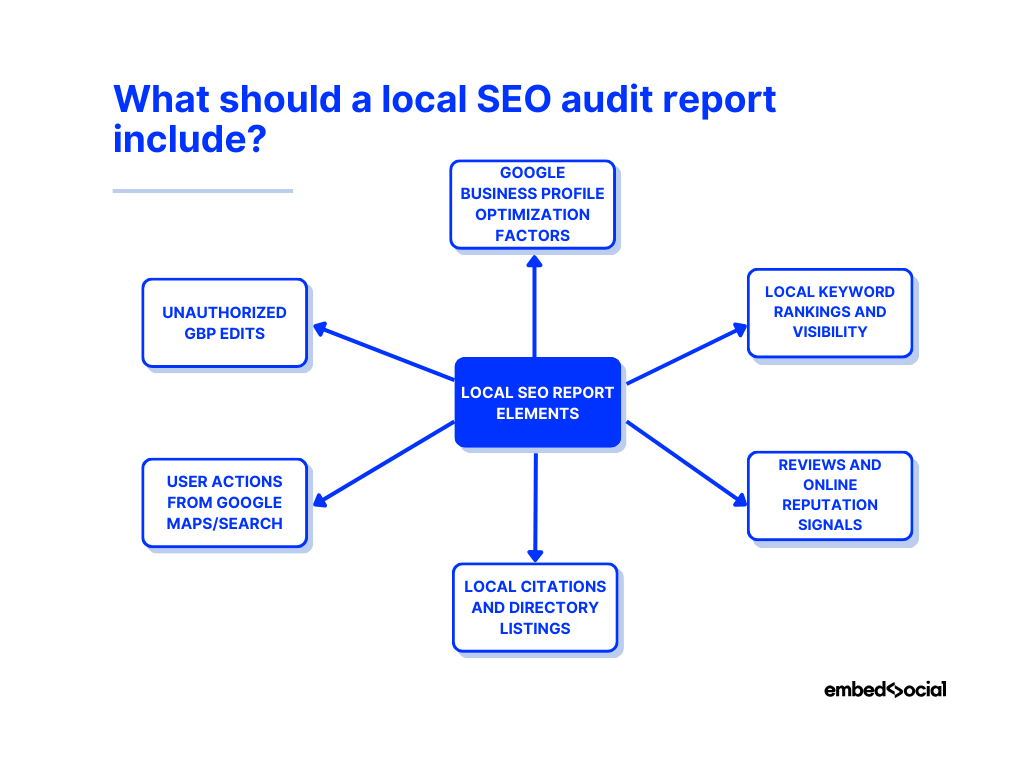
Google Business Profile optimization factors
First things first, you must always seek to optimize your Google Business Profile, and towards that goal, you must check for NAP consistency, correct categories, services, business hours, and complete GBP info to boost your local relevance.
Pro tip: Use a tool that flags missing business details automatically, such as missing images, unclaimed categories, or low GBP completeness.
Local keyword rankings and visibility
Track how your business ranks for key local terms in specific areas to spot opportunities and gaps. Check your top keywords at a glance and see where your competitors do better.
Tool tip: The best tools show you your current keyword rankings and suggest keywords you’re missing, and even highlight if those terms are in your business name or description.
Reviews and online reputation signals
Since adding Google reviews to a website is of crucial importance to any modern business, regardless of size, type, and industry, you must be able to view your total review count, average rating, review growth, and whether you’re actively responding to customers.
Insight note: Responding to every review (even negative ones) improves your trust score and is often factored into local ranking signals.
Local citations and directory listings
You have to ensure that your local citations—online mentions of your business information—are accurate across the Internet. So, make sure your business name, address, and phone number are consistent across all major directories.
Pro tip: Run regular citation scans to catch outdated listings or duplicate entries that might hurt your credibility in the long run.
User actions from Google Maps/Search
Get Google Business Profile insights like website clicks, calls, direction requests, and bookings from your GBP. Plus, the number of published posts and response metrics.
Insight note: While Google gives you this data, you have to make sure your report interprets it clearly (e.g., trends or drop-offs over time).
Unauthorized GBP edits
Quality tools will also let you know if anyone has tried changing your GBP information without your permission (Google allows the public to do that) and stop them (or, in effect, change them back per your preference).
Tool tip: Some tools, like EmbedSocial, allow you to keep track of all the edits made to your Google locations and help you lock your information.
How to create a local SEO report in 5 simple steps?
Creating a local SEO report is not complicated at all with the right tools and a clear structure. Here’s how to build a report that’s both insightful and actionable:
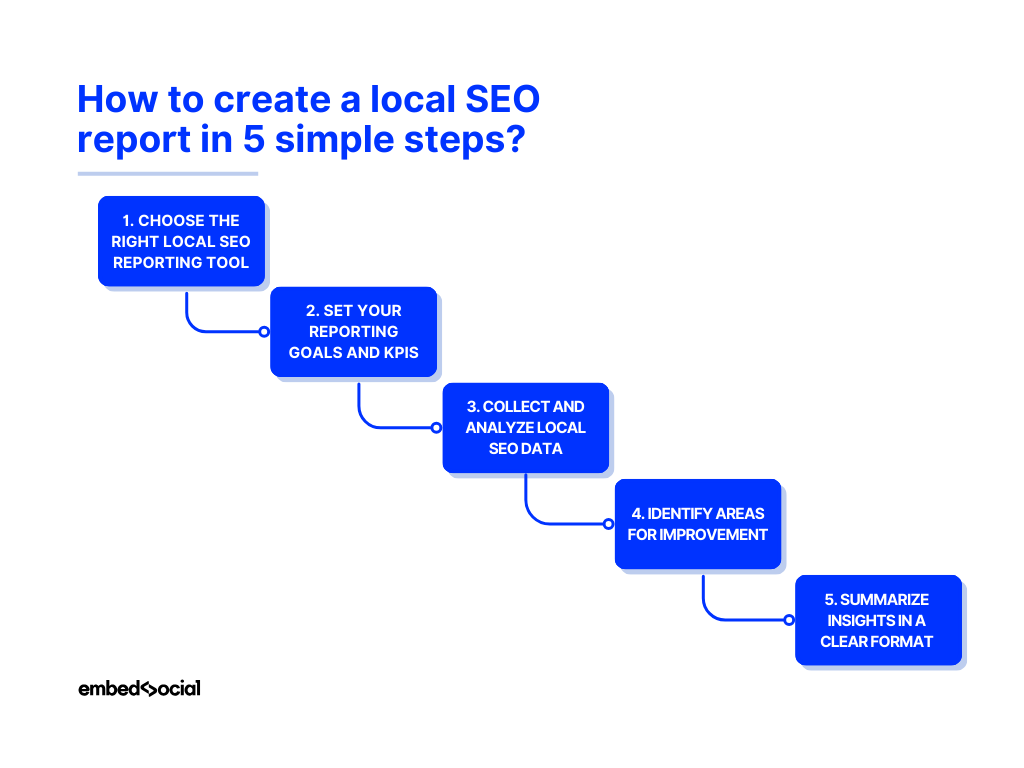
1. Choose the right local SEO reporting tool
Firstly, you should select a tool that fits your business needs. However, before subscribing to any platform, you should check out Google’s offering, as it offers some of the data you need, albeit it requires you to spend time and effort to collect it.
To speed things up, you can look into platforms like EmbedSocial or BrightLocal, which offer automated reports, including GBP health scores, action-based recommendations, keyword insights, and alerts for unauthorized edits—everything you need in one place.
2. Set your reporting goals and KPIs
However, before diving into any data, you must decide what success looks like for you. Are you tracking rankings, traffic, leads, or profile completeness?
Whether you want to rank higher on Google Maps or respond to more reviews, setting specific goals will help you focus your report on what matters most.
Pro tip: EmbedSocial lets you tailor insights by location and compare performance over time, so you can measure against your exact KPIs.
3. Collect and analyze local SEO data
Once you start collecting your data (manually or via a tool), you can start analyzing it by yourself or via the tool you used to get it in the first place.
You can use all these GBP insights, keyword data, review metrics, and more to find optimization opportunities. Thankfully, EmbedSocial automatically does this for each GBP location and flags what’s missing based on the impact they have on your business:
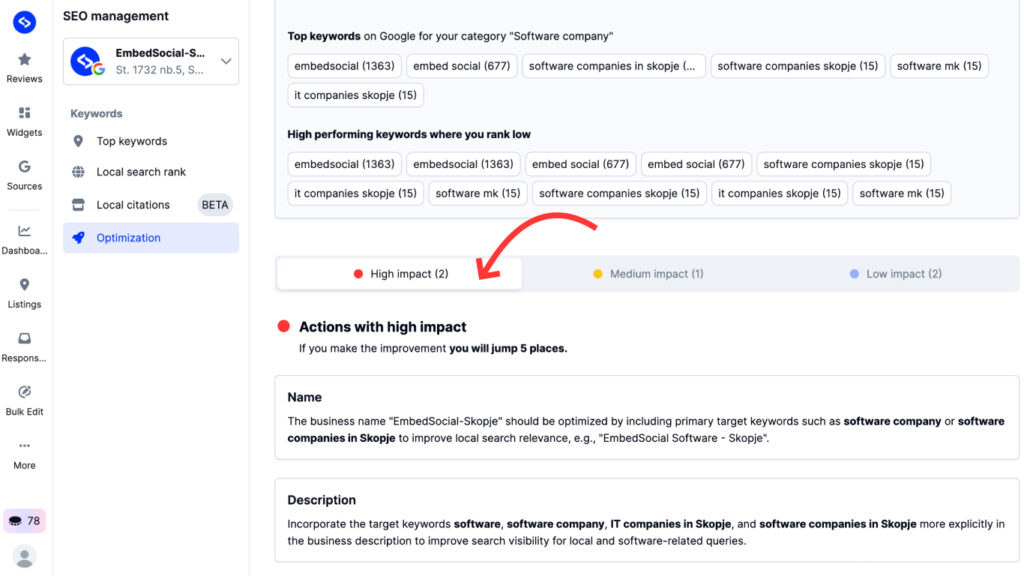
Pro tip: Collect data weekly or monthly to track trends, not just snapshots.
4. Prioritize actions
Now it’s time to turn data into decisions. Focus on what will move the needle fastest. Meaning, you should prioritize actions with the highest impact (as shown above).
Needless to say, you should focus on the most critical issues first (red), then address essential but non-urgent tasks (yellow), and finally do the suggested improvements (blue).
Use the upcoming features in EmbedSocial to do all these actions in one place, such as updating the suggested business description, bulk uploading of photos, using an AI agent to reply to reviews, or scheduling posts on your Google business profile.
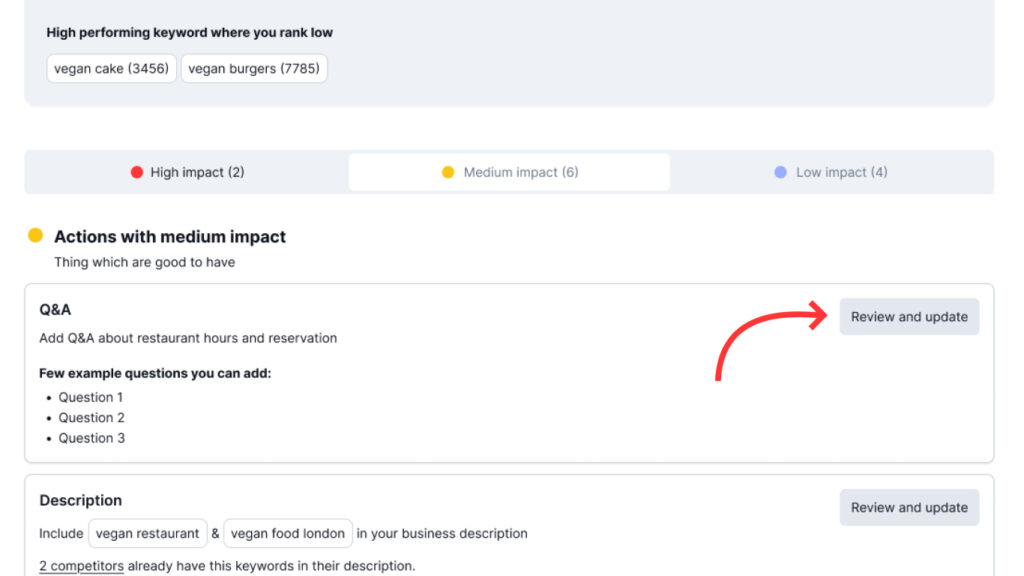
Pro tip: Fixing just 2–3 red issues often leads to visible jumps in Maps rankings.
5. Summarize insights in a clear format
Finally, you must make your data understandable to all stakeholders. As such, you can use charts, tables, and/or visual scores.
Or, you can let your third-party tool do the formatting for you, such as EmbedSocial’s optimization report, which offers a performance score, keyword insights, and a visual breakdown of actions to take—making it ideal for quick reviews and regular audits.
Tool tip: Save time by sharing reports or live dashboards with your team or clients.
How to use your SEO report to rank higher on Google Maps: 5 best practices
You can make the most out of your local SEO optimization report by following a few best practices. Here’s how to boost your Google Maps rankings with ease:
Optimize your Google Business Profile based on report data
Use the report to spot missing or incorrect elements in your GBP, such as business names, category selection, outdated services, or a weak description.
👉 Real-life example: A dental clinic updated its category from “Medical Center” to “Dental Clinic” and added missing services like “Teeth Whitening” after reviewing their audit. Within weeks, their Maps visibility for local searches improved by 32%.
Improve reviews and respond to feedback
Your report should tell you how often you’re getting reviews, whether they’re positive, and if you’re replying. All of these affect local rankings and trust signals.
👉 Real-life example: A restaurant chain noticed from its report that locations with more review responses ranked higher. By assigning team members to reply to all reviews within 48 hours, they saw ranking improvements in 7 out of 10 locations.
Add your business to all popular local business sites
You must maintain an up-to-date business profile on all popular business listing sites, such as Google, Yelp, Bing, Apple Maps, Facebook, Yellow Pages, etc.
👉 Real-life example: A multi-location gym updated its NAP information and completed its business profile on Google before transferring that information across all popular local business listing sites to boost its customer calls by 18% over the following 3 months.
Improve local keyword targeting
Your SEO report should show what keywords you rank for and where you’re falling short. Update your content, Google posts, and GBP fields based on these gaps.
👉 Real-life example: A spa discovered they weren’t ranking for “massage therapy near me” despite offering the service. After adding the keyword to their GBP description and posts, they broke into the local 3-pack for that search within 10 days.
Set a regular audit schedule
Don’t let your local search rankings stagnate. Use your report weekly or monthly to spot trends, new issues, and wins you can double down on.
👉 Real-life example: A real estate agency began scheduling monthly SEO reports and noticed a steady drop in visibility for one location. Catching it early helped them fix outdated hours and missing photos—restoring traffic in under two weeks.
EmbedSocial – The best all-in-one GBP and local SEO tool
EmbedSocial is one of the best Google Business Profile management tools that includes everything you may need to set up, optimize, and maintain your Google locations.
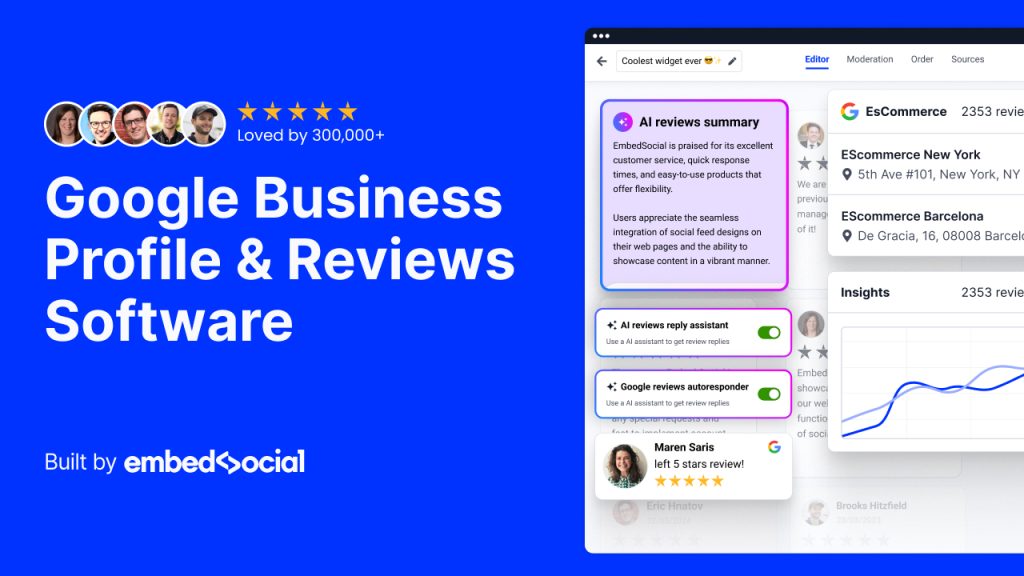
What makes EmbedSocial the right choice for any business is its direct GBP API connection, which facilitates up-to-date information access and editing privileges.
Here are the key features that make EmbedSocial the go-to platform for managing Google Business Profiles and improving your local SEO performance:
- Top-performing keywords tracking—monitor which keywords your locations rank for and identify keyword gaps instantly;
- Local search rank insights—see how your business ranks in Google Search and Maps for different keywords across multiple locations;
- Local citations tracking—audit your citation consistency across the web to ensure accuracy and improve trust signals;
- GBP optimization reports—get a visual optimization report with a 100/100 health score, keyword relevance, and color-coded improvement actions;
- Action-based recommendations—prioritized suggestions (high, medium, low impact) that tell you exactly how to optimize your listing step-by-step;
- Unauthorized edits monitoring—be instantly alerted if someone tries to change your GBP info and lock your preferred data in place;
- Bulk SEO reporting for multi-location brands—manage and generate reports for all your locations from one dashboard;
- Edit logs for transparency—track every change made to your Google listings, including who edited what and when;
- Historical reports archive—access past reports to track progress, compare metrics, and show results over time;
- Easy navigation and publishing tools—direct access to listings, responses, posts, and bulk edits all in one sidebar;
- Multi-location SEO management at scale—whether you manage 1 location or 1,000, the platform is built to grow with you.
You get all of the above plus a local SEO AI agent for just $9/month for 2 locations. So sign up today or try our 7-day free trial to try out all these features.
Conclusion: Local SEO reports unlock real growth for your brand!
You first need clarity about your local business performance if you are looking to improve its success, and that’s exactly what a good report delivers.
Once you start reading such reports, you’ll stay in the loop of what’s working, what needs fixing, and where your next wins are hiding.
So start analyzing data on keyword rankings, reviews, citations, and profile activity to confidently make improvements that help your business rank higher.
At the end of the day, when you combine reporting with regular Google Business Profile optimization, you’ll rank higher on Google Maps and get real-world results.
👉 Ready to improve your local visibility?
Run your first SEO optimization report with EmbedSocial and see exactly what’s holding your Google Business Profile back—then fix it in just a few clicks.
FAQs on local SEO reports
What is a local SEO audit report?
A local SEO audit report analyzes how your business performs in local search and shows what to improve on your Google Business Profile, website, and local listings.
How to do an SEO report?
Use tools to collect data on rankings, reviews, profile completeness, and local visibility, then summarize your findings with actionable steps for improvement.
What should I include in a local SEO report?
Include GBP optimization factors, keyword rankings, reviews, citations, on-page SEO, local traffic actions, and conversion metrics.
How to check the SEO optimization of your business?
Use a tool like EmbedSocial to review your optimization score, see ranking keywords, and get action-based suggestions to boost local visibility.
How do I optimize my Google Business Profile using a report?
Identify missing details, weak categories, low-ranking keywords, and unresponded reviews—then follow the report’s action tips to fix them.
What tools can help me generate local SEO reports?
Tools like EmbedSocial, BrightLocal, ReportingNinja, or Google’s GBP Insights can help you generate structured, automated reports.
How often should I run a local SEO audit?
You should run a full audit monthly, with weekly check-ins on rankings, reviews (especially important), and GBP updates to stay ahead of changes.
